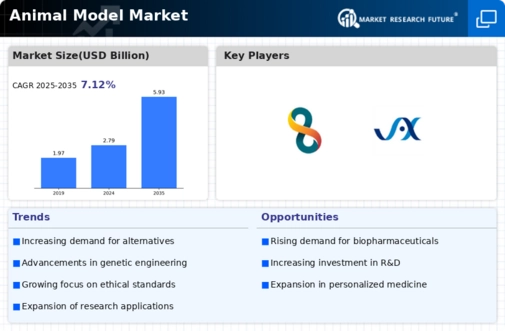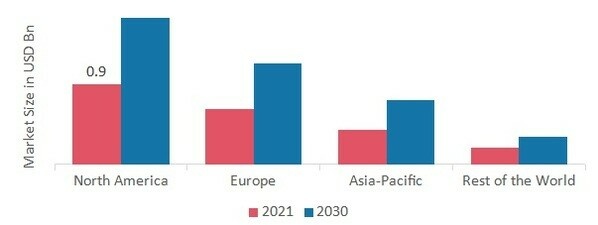Market Trends
Introduction
As we take a look at the Animal Model Market in 2025, we see several macro-economic factors influencing its evolution. Gene therapy and biopharmaceuticals are enabling the development of more sophisticated and relevant animal models, which will lead to better research results. Meanwhile, regulatory pressures are intensifying, with the introduction of stricter ethical and animal-welfare guidelines, forcing the industry to adapt its practices. Also, a shift in consumer preferences towards a more sustainable and individualized approach to medicine is encouraging companies to focus their efforts on innovation. These macro-economic factors are vital for companies to understand, as they are not only shaping their competitive strategies, but also influencing the way they operate in the wider social and regulatory context.
Top Trends
-
Increased Demand for Genetically Engineered Models
The rise of precision medicine has brought a huge increase in demand for genetically engineered animal models, and companies like Horizon Discovery Group PLC are leading the way. By 2025, more than 60% of research institutions are expected to be using these models in drug development. These developments will improve the accuracy of preclinical studies, reducing the risk of late-stage clinical failures. The future will see the introduction of more complex gene-editing techniques, which will further increase the accuracy of these models. -
Regulatory Support for Animal Research
The regulatory authorities are more and more aware of the importance of animal models in biomedical research and are easing their approval procedures. For example, the Food and Drug Administration (FDA) has issued guidelines that facilitate the use of animal models in drug testing. This is expected to lead to greater efficiency in research and faster drug development. As the regulatory framework evolves, compliance with the rules will become an increasingly important factor for the industry. -
Focus on Animal Welfare and Ethical Standards
Animal welfare in research is becoming an increasingly important consideration, both in terms of public opinion and legislation. Higher ethical standards, such as those adopted by Charles River Laboratories, are becoming a source of competitive advantage. Surveys show that up to 75% of consumers prefer to buy products developed using humane methods. This trend may lead to higher costs, but it can also enhance brand loyalty and market reputation. -
Integration of AI and Machine Learning
Artificial intelligence and machine learning are transforming data analysis and prediction in animal model research. Companies are using these methods to improve the accuracy of experimental results, with studies demonstrating a 30% increase in the success rate of predictions. This trend will help to speed up the development of new drugs and shorten the time to market. Advances in this area could even lead to the development of fully automated research environments. -
Expansion of Contract Research Organizations (CROs)
The role of contract research organisations in the animal model market is growing. By offering specialised services, they are able to relieve the burden on pharmaceutical companies. It is estimated that by 2025, up to 40% of preclinical research will be outsourced to CROs like Envigo. This trend offers the advantages of cost savings and access to advanced technology, while allowing companies to focus on their core business. Competition and innovation in the sector are likely to increase as CROs continue to expand. -
Emergence of Personalized Animal Models
Using the concept of personal medicine, a custom-made model of the patient’s disease is being developed. A company called Transposagen Biopharmaceuticals is an example of this. The aim of this development is to make preclinical research more relevant, which could lead to improved results in clinical trials. This development could also lead to more individualized treatment. -
Sustainability Initiatives in Animal Research
The use of animal models is becoming a matter of great importance in the animal model industry, and the practice of companies is now aimed at reducing the impact on the environment. There are several initiatives to reduce waste and improve resource efficiency. It is both the regulatory pressure and the consumers' demands for sustainable development that have prompted this development. In the future, it may also be possible to use other animal models, which reduce the use of live animals even further. -
Globalization of Animal Model Research
Research is becoming increasingly international. The globalization of scientific activities facilitates the exchange of animal models and data. The formation of international collaborations between companies is expected to increase the diversity of animal models available for research. This trend may lead to increased innovation and a better understanding of the pathophysiology of diseases. The future may also bring a greater use of standardized procedures that facilitate reproducibility. -
Advancements in Non-Invasive Techniques
Non-intrusive methods of investigation, such as the use of non-destructive, non-stunning means of observation and recording, are revolutionizing the way in which animal models are studied. Several companies have developed methods for obtaining more accurate data by means of a greater ability to follow up physiological changes. The accuracy of the results has been reported as increasing by 25 per cent. This development will undoubtedly improve the quality of research and reduce the need for invasive procedures. And future developments may lead to even more accurate recording. -
Rise of Companion Animal Models
In the United States the use of pet animals in research has become more common, especially in the study of human diseases. In the case of dogs and cats, companies are looking for a variety of uses. Preliminary studies have yielded some encouraging results. This trend is expected to broaden the scope of research and increase the translational value of research findings. Future developments will probably include more comprehensive studies that validate the use of these models.
Conclusion: Navigating the Animal Model Market Landscape
In the year 2025, the Animal Model Market will become more fragmented. The monopoly will be shared by the traditional and the new players. The established companies will use their experience and established network, and the new entrants will focus on innovation and research methods, such as the use of artificial intelligence and automation to increase efficiency. The geographical trend is that the importance of ethics and environmentalism is increasingly prominent, and companies need to adjust their strategies accordingly. In order to adapt to the changing market, companies need to have the flexibility of their products and services. In order to achieve the leading position in the Animal Model Market, the companies should be able to respond quickly to the changes in regulations and market demands. The key to the future development of the Animal Model Market is the integration of advanced technology and sustainable development.





Leave a Comment